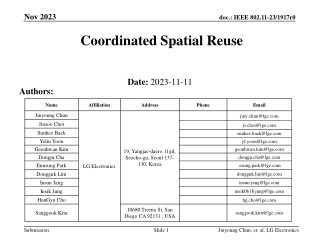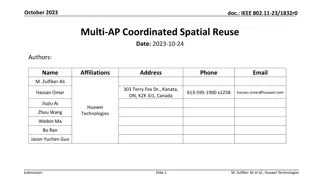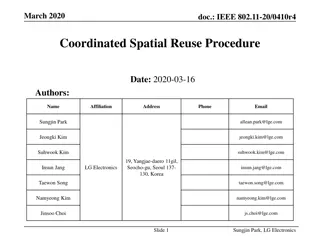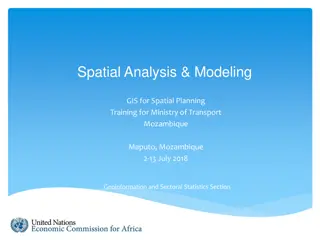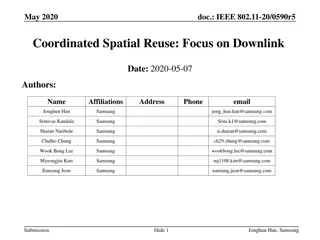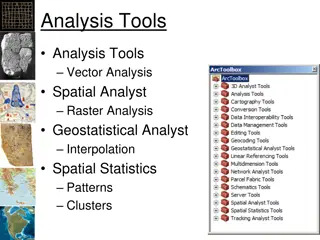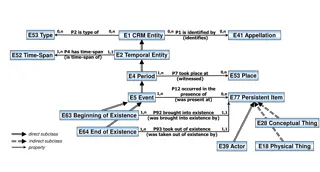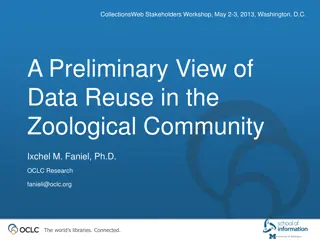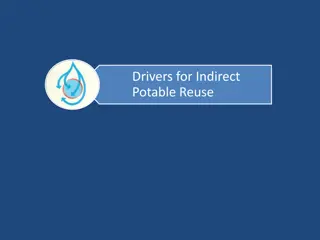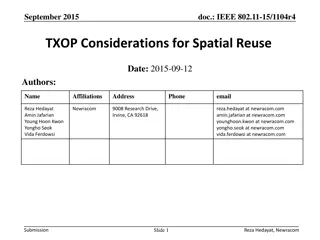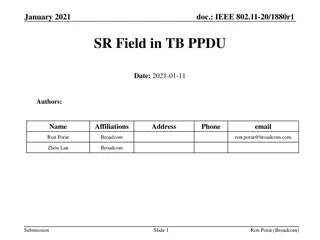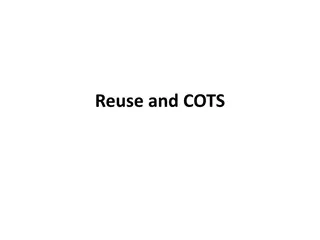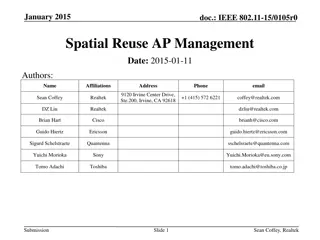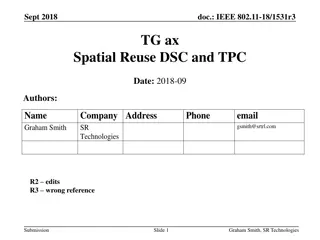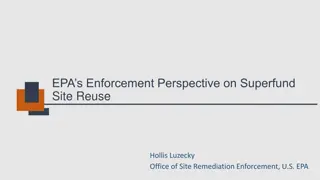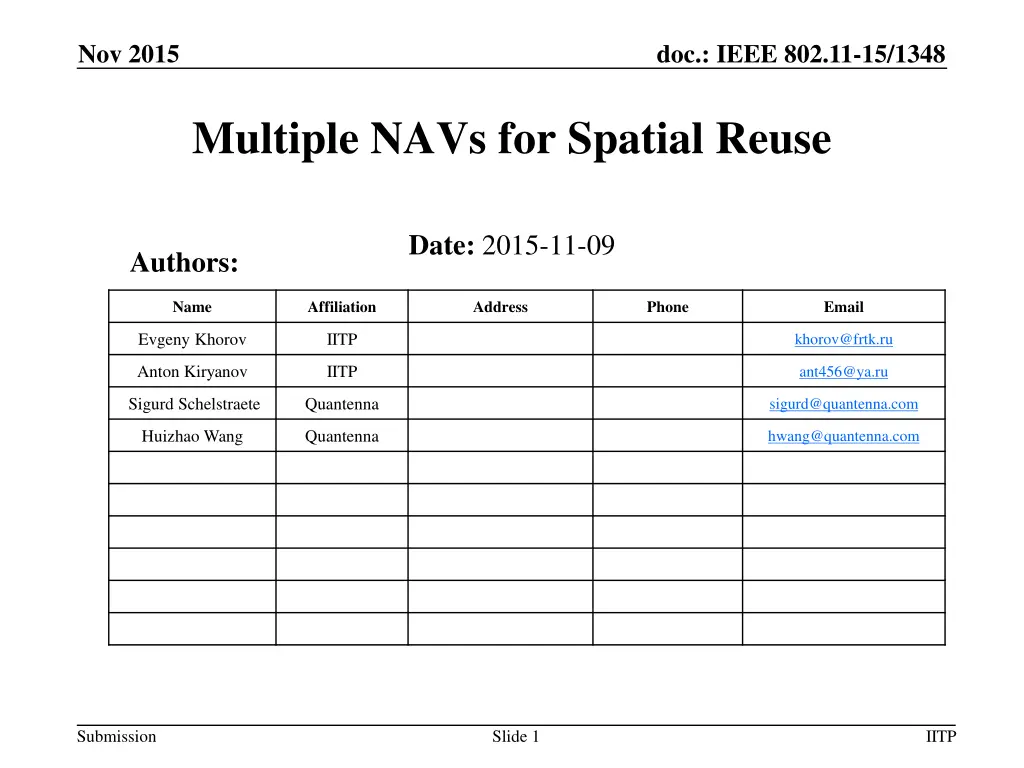
IEEE 802.11-15/1348: Solving NAV Reset Issues in Wireless Networks
Explore the challenges related to NAV reset in IEEE 802.11-15/1348 standard for spatial reuse in wireless networks. The document discusses issues with NAV updates caused by intra-BSS and OBSS frames, proposing a solution using multiple NAVs to enhance network efficiency and avoid collisions.
Download Presentation

Please find below an Image/Link to download the presentation.
The content on the website is provided AS IS for your information and personal use only. It may not be sold, licensed, or shared on other websites without obtaining consent from the author. If you encounter any issues during the download, it is possible that the publisher has removed the file from their server.
You are allowed to download the files provided on this website for personal or commercial use, subject to the condition that they are used lawfully. All files are the property of their respective owners.
The content on the website is provided AS IS for your information and personal use only. It may not be sold, licensed, or shared on other websites without obtaining consent from the author.
E N D
Presentation Transcript
Nov 2015 doc.: IEEE 802.11-15/1348 Multiple NAVs for Spatial Reuse Date: 2015-11-09 Authors: Name Affiliation Address Phone Email Evgeny Khorov IITP khorov@frtk.ru Anton Kiryanov IITP ant456@ya.ru Sigurd Schelstraete Quantenna sigurd@quantenna.com Huizhao Wang Quantenna hwang@quantenna.com Submission Slide 1 IITP
doc.: IEEE 802.11-15/1348 NAV Reset Rules Current 802.11 [1] specifies that in a non-DMG BSS, a STA shall interpret the reception of a CF-End frame as NAV reset, i.e., it resets its NAV timer to 0 at the end of the PPDU containing this frame. Current .11ax SFD also contains the following rule: When a STA receives a CF-End from an OBSS STA, if the last NAV update was caused by an intra-BSS frame, the STA should not reset its NAV. (MAC Motion 33, September 17, 2015, see [2]). As shown in [2], it helps to avoid resetting the NAV set by myBSS frame due to an OBSS CF-End frame and prevent possible collisions What for: - a CF-End from intra-BSS STA, if the last NAV update was caused by an OBSS frame; - a CF-End from an OBSS STA, if the last NAV update was caused by another OBSS frame? Submission Slide 2 IITP
doc.: IEEE 802.11-15/1348 Current .11ax SFD When a STA receives a CF-End from an OBSS STA, if the last NAV update was caused by an intra-BSS frame, the STA should not reset its NAV. (MAC Motion 33, September 17, 2015, see [2]). STA1a CTS ACK Frame RTS CF-end BSS1 AP1 STA2b does not reset NAV STA2b s TX range STA2b STA2b sets NAV AP2 STA2b sets NAV CTS BSS2 RTS Frame STA2a Submission Slide 3 IITP
doc.: IEEE 802.11-15/1348 Problem When a STA receives a CF-End from an OBSS STA, if the last NAV update was caused by an intra-BSS frame, the STA should not reset its NAV. (MAC Motion 33, September 17, 2015, see [2]). When a STA receives a CF-End from an intra-BSS STA, if the last NAV update was caused by an OBSS frame, there is a problem STA1a CTS ACK STA1b reset NAV RTS CF-end Frame BSS1 AP1 STA1b s TX range RTS STA1b STA1b sets NAV Collision AP2 STA1b sets NAV CTS BSS2 Frame RTS STA2a Submission Slide 4 IITP
doc.: IEEE 802.11-15/1348 A More Complex Problem When a STA receives a CF-End from an OBSS STA, if the last NAV update was caused by another OBSS frame, ... STA1 CTS ACK BSS1 RTS CF-end Frames AP1 AP2 transmits STA2 AP2 resets NAV AP2 sets NAV BSS2 Frame AP2 AP2 increases NAV AP2 s TX range Collision STA3 CTS BSS3 RTS Frames AP3 It is not sufficient to distinguish just between Intra-BSS and OBSS frames. Submission Slide 5 IITP
doc.: IEEE 802.11-15/1348 Solution Problem: The NAV value is set by a frame from one BSS and is reset by a frame from another BSS. Solution: Use multiple NAVs. Each NAV corresponds to a particular BSS. STA1 CTS ACK BSS1 RTS CF-end Frames AP1 AP2 does NOT transmit because of NAV2! STA2 AP2 resets NAV1 AP2 sets NAV1 BSS2 AP2 AP2 sets NAV2 AP2 s TX range STA3 CTS BSS3 RTS Frames AP3 Submission Slide 6 IITP
doc.: IEEE 802.11-15/1348 Multiple NAVs Details Each STA maintains multiple NAVs. Each NAV corresponds to a particular BSS heard by the STA. E.g., in case of 3 BSSs operating in the same area, each STA maintains 3 NAVs: one NAV for its own BSS and the other 2 NAVs for the alien 2 BSSs. NAV corresponding to a particular BSS can be reset or increased only by reception of frames from that BSS. Since some frames may not contain BSSID (e.g. CTS, etc.), BSS color can be used to distinguish overlapped BSSs. If at least one NAV indicates that the medium is busy, then the medium is considered to be busy. Note: The concept of multiple NAVs does not forbid using adaptive CCA thresholds. A history of the multiple NAV concept can be found in [3]. Submission Slide 7 IITP
doc.: IEEE 802.11-15/1348 Multiple NAVs Complexity Memoryusage The number of NAVs at a STA is limited by the number of BSS colors. B. The STA may keep only N (e.g., N=2 or 3) highest NAVs with the corresponding colors A. In practice, the STA only needs to track as many NAVs as the number of colors it sees Computational complexity When a NAV value is set (increased) the STA shall B. check whether this value is among N highest ones, update them and maxNAV if necessary A. update the necessary NAV value, check whether this value is greater than current maxNAV and update maxNAV if necessary When a CF-end is received the STA shall A. reset the necessary NAV, find the maximum value over remaining NAVs and update maxNAV if necessary B. check whether NAV to be reset is among N highest ones, reset it if necessary and update maxNAV if necessary Submission Slide 8 IITP
Sept 2015 doc.: IEEE 802.11-15/1348 Straw Poll 1 Do you agree to add the following text in SFD: An HE STA should have a mechanism to remember and distinguish NAVs set by intra-BSS frame and OBSS frame. A CF-end frame that comes from intra-BSS (OBSS) should not reset NAV that was set by a frame from OBSS (intra-BSS). To determine which BSS is the origin of a frame, the HE STA may use BSS color. Y N A Submission Slide 9 IITP
Sept 2015 doc.: IEEE 802.11-15/1348 Straw Poll 2 Do you agree to add the following text in SFD: An HE STA should have a mechanism to remember and distinguish NAV values set by frames from different BSSs. A CF-end frame that comes from one BSS should not reset NAV that was set by a frame from another BSS. To determine which BSS is the origin of a frame, the HE STA may use BSS color. Y N A Submission Slide 10 IITP
Sept 2015 doc.: IEEE 802.11-15/1348 Reference [1] IEEE P802.11-REVmcTM/D4.0 [2] Jeongki Kim (LG Electronics), 15/1067r0 MU TXOP truncation . [3] Mathilde Benveniste (Avaya Labs), 04/1093r4 Multiple NAV Protection Revisited Multiple NAV Protection Revisited Submission Slide 11 IITP

